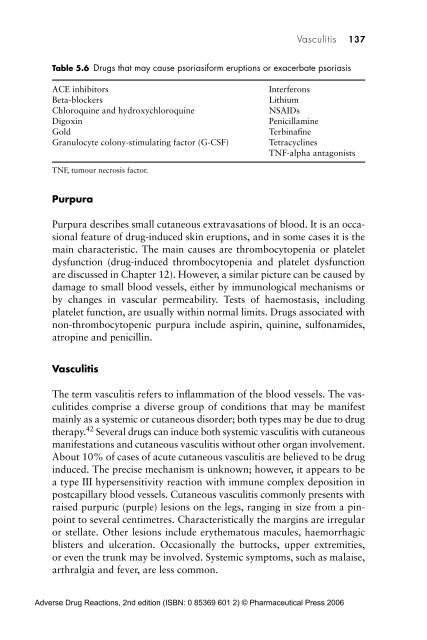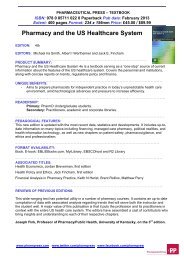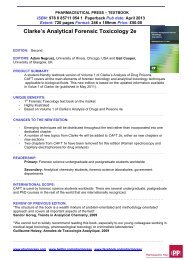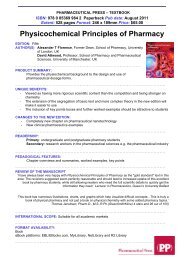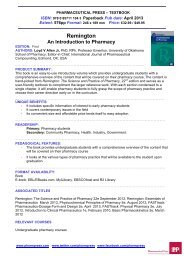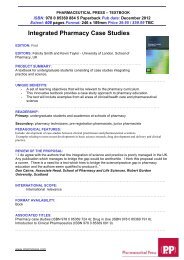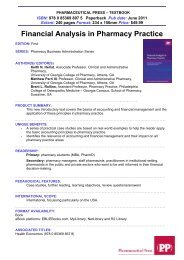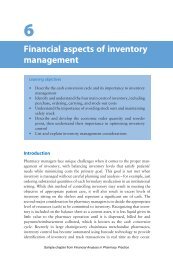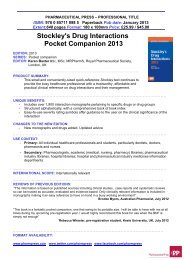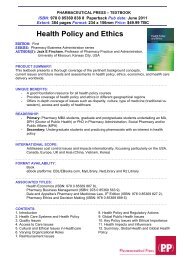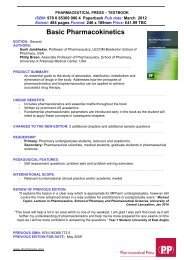Drug-induced skin reactions - Pharmaceutical Press
Drug-induced skin reactions - Pharmaceutical Press
Drug-induced skin reactions - Pharmaceutical Press
You also want an ePaper? Increase the reach of your titles
YUMPU automatically turns print PDFs into web optimized ePapers that Google loves.
Vasculitis 137<br />
Table 5.6 <strong>Drug</strong>s that may cause psoriasiform eruptions or exacerbate psoriasis<br />
ACE inhibitors<br />
Beta-blockers<br />
Chloroquine and hydroxychloroquine<br />
Digoxin<br />
Gold<br />
Granulocyte colony-stimulating factor (G-CSF)<br />
Interferons<br />
Lithium<br />
NSAIDs<br />
Penicillamine<br />
Terbinafine<br />
Tetracyclines<br />
TNF-alpha antagonists<br />
TNF, tumour necrosis factor.<br />
Purpura<br />
Purpura describes small cutaneous extravasations of blood. It is an occasional<br />
feature of drug-<strong>induced</strong> <strong>skin</strong> eruptions, and in some cases it is the<br />
main characteristic. The main causes are thrombocytopenia or platelet<br />
dysfunction (drug-<strong>induced</strong> thrombocytopenia and platelet dysfunction<br />
are discussed in Chapter 12). However, a similar picture can be caused by<br />
damage to small blood vessels, either by immunological mechanisms or<br />
by changes in vascular permeability. Tests of haemostasis, including<br />
platelet function, are usually within normal limits. <strong>Drug</strong>s associated with<br />
non-thrombocytopenic purpura include aspirin, quinine, sulfonamides,<br />
atropine and penicillin.<br />
Vasculitis<br />
The term vasculitis refers to inflammation of the blood vessels. The vasculitides<br />
comprise a diverse group of conditions that may be manifest<br />
mainly as a systemic or cutaneous disorder; both types may be due to drug<br />
therapy. 42 Several drugs can induce both systemic vasculitis with cutaneous<br />
manifestations and cutaneous vasculitis without other organ involvement.<br />
About 10% of cases of acute cutaneous vasculitis are believed to be drug<br />
<strong>induced</strong>. The precise mechanism is unknown; however, it appears to be<br />
a type III hypersensitivity reaction with immune complex deposition in<br />
postcapillary blood vessels. Cutaneous vasculitis commonly presents with<br />
raised purpuric (purple) lesions on the legs, ranging in size from a pinpoint<br />
to several centimetres. Characteristically the margins are irregular<br />
or stellate. Other lesions include erythematous macules, haemorrhagic<br />
blisters and ulceration. Occasionally the buttocks, upper extremities,<br />
or even the trunk may be involved. Systemic symptoms, such as malaise,<br />
arthralgia and fever, are less common.<br />
Adverse <strong>Drug</strong> Reactions, 2nd edition (ISBN: 0 85369 601 2) © <strong>Pharmaceutical</strong> <strong>Press</strong> 2006


